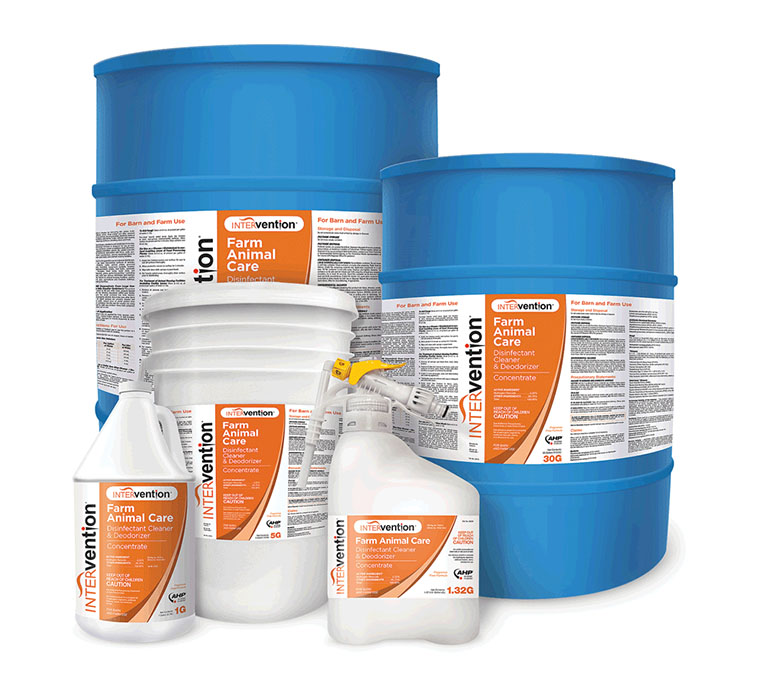Virox brings its globally patented accelerated hydrogen peroxide disinfectant technology to the animal health sector with the Intervention Farm Animal Care Disinfectant Cleaner and Deodorizer product line

Finding the right biosecurity solution to protect farms from costly disease outbreaks is becoming increasingly important to pork producers. It is also the focus of Virox Animal Health. As a leader in human health care infection prevention, Virox brings its globally patented accelerated hydrogen peroxide (AHP) disinfectant technology to the animal health sector with the Intervention Farm Animal Care Disinfectant Cleaner and Deodorizer product line to help fight emerging pathogens and prevent outbreaks.
Intervention disinfectant cleaners provide pork producers a cleaner, faster and more sustainable approach to biosecurity and infection prevention, says Alan Haslett, Virox senior director of strategic alliances. Hydrogen peroxide is widely known as an effective disinfectant technology that has been used for hundreds of years. Hydrogen peroxide is used at 3%, which typically kills pathogens in 10 to 20 minutes. The Virox open innovation research and development teams were able to stabilize and harness the power of hydrogen peroxide to dramatically speed up the disinfection time against a broad spectrum of pathogens.
“What 3% hydrogen peroxide might have disinfected in 10 to 20 minutes, we can do with 0.5% or less hydrogen peroxide in one to five minutes, half the time of other disinfectant technologies available today,” explains Haslett. “Peroxide breaks down into water and oxygen, leaving no active residual chemistry on the surface. This prevents residual buildup and potential disinfectant antimicrobial resistance that we are seeing in both animal and human health. Unlike AHP, many of the traditional disinfectant chemistries do leave active residuals on the surface.”
Virox offers the Intervention disinfectant product line in various formulations and formats to meet the livestock producers’ biosecurity needs. It is easy to use and requires no personal protection equipment at in-use solutions. The line of concentrates is available in different format sizes ranging from a 55-gallon drum to a 1-gallon bottle, including an innovative, ready-to-dispense bottle with the dispensing equipment built in. Ready-to-use liquids and wipes have received U.S. EPA approval and will be available in the fall of 2016. Moreover, the product does not require special disposal due to its superior environmental profile and has a shelf life of three years for the concentrate product and 90 days for the diluted solution.
After years of third-party validation and acceptance within the scientific community, Virox received EPA approval for a broad spectrum of animal health specific claims that will provide the livestock producer with a new solution in the fight against costly pathogens.
Tests in the field confirm Intervention’s effectiveness in reducing virus transmission. An Iowa State University research team led by Derald Holtkamp compared the effectiveness on five classes of disinfectants — including AHP and Synergize — to reduce virus transmission on livestock transport vehicles. While both AHP and Synergize were effective at inactivating porcine reproductive and respiratory syndrome virus by 15 minutes, AHP decreased the amount of PRRSV faster than Synergize and no disinfectant. In the conclusion, the researchers note, “When time constraints prevent the gold standard of cleaning, disinfecting and drying of trailers, a limited washing procedure combined with the proper use of a disinfectant, such as AHP, is effective at inactivating the presence of PRRSV in the environment.”
A team of ISU researchers tested AHP’s ability to inactivate porcine epidemic diarrhea virus in two separate studies — one conducted at room temperature, the other in cold-weather conditions. The first study tested AHP diluted at 1:16 and 1:32 at room temperature, which successfully inactivated PEDV in the presence of heavy and light fecal loads. In the second study, AHP was tested using a 1:16 and 1:32 dilution with a 10% propylene glycol solution to prevent the solution from freezing at -10 degrees C, using contact times of 40 and 60 minutes. The key finding was the ability of AHP to kill 100% of PEDV in a 25% soil challenge, showcasing AHP’s tremendous efficacy.
Reducing the risk of exposure to both harsh chemicals and harmful pathogens for humans, animals and environment put Intervention in the win column for the New Product Tour panel. The fact that AHP leaves no active residues behind on surfaces, which can contribute to antimicrobial resistance in relation to disinfectants, combined with AHP’s ease of use, make AHP an appealing disinfectant technology.
Panel member and swine veterinarian Aaron Lower says, “Hog producers are currently using Intervention products in the barns, especially for high-risk applications such as loading chutes, trucking washes, vehicles and employees’ entrances. AHP’s real advantage is disinfecting in the presence of organic matter.”
Lower urges producers to calculate the return on investment value for each sanitization process on the farm to find the right product with the optimal performance for the best value.
Learn more about Intervention at viroxanimalhealth.com.
About the Author(s)
You May Also Like



